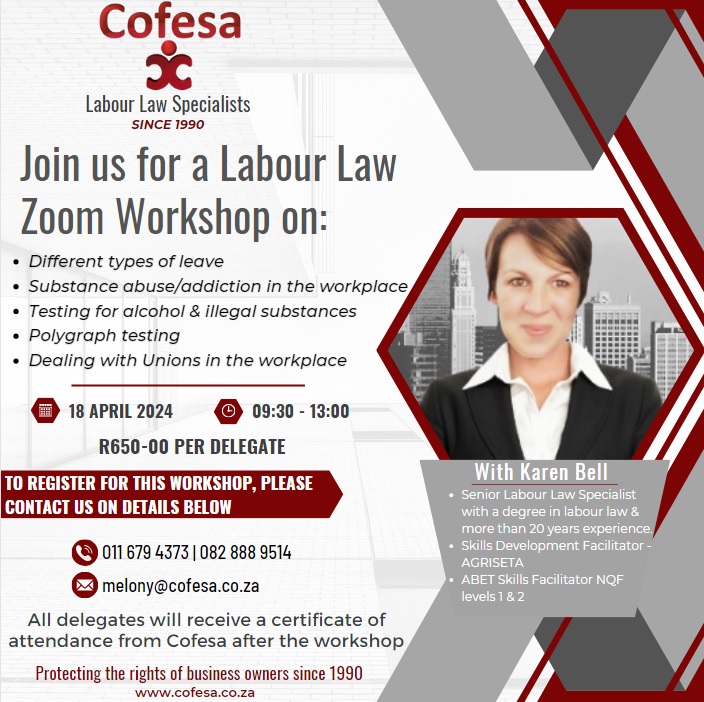INTRODUCTION
The COVID-19 Regulations issued by the government have required persons to work from home, where they can. As we have engaged with our clients on a daily basis, one of the key questions is whether a person’s home becomes a “workplace” if an employee performs his/her services from their home/residence.
This has important consequences under South Africa’s Health and Safety Laws, and for purposes of compensation for occupational injuries and diseases.
It is likely that employees will continue working from home in compliance with the COVID-19 Regulations issued in terms of the Disaster Management Act (“Covid Regulations”). In addition, working from home during the hard lockdown, and under Alert Level 4, has demonstrated that the drive towards flexible or agile working arrangements has merit, and working from home may become more common, even after the threat of COVID-19 has been addressed.
SOUTH AFRICAN HEALTH AND SAFETY LAWS AND COMPENSATION LAWS
In South Africa, a distinction is made between the provisions of Health and safety Laws, which regulate health and safety in the workplace, namely the Occupational Health and Safety Act, No. 85 of 1993 (“OHSA”) and the Mine Health and Safety Act, No. 29 of 1996 (“MHSA”), and compensation that becomes payable in the event that an employee sustains an occupational injury or contracts an occupational disease which is compensatable.
All injuries (non-fatal and fatal injuries) are compensatable under the Compensation for Occupational Injuries and Diseases Act, No. 130 of 1993 (“COIDA”).
With regard to the Compensation Laws, COIDA applies to all employers, regardless of the industry.
Occupational diseases are also compensatable under COIDA, and occupationally-acquired COVID-19, is a compensatable disease under COIDA.
WHAT CONSTITUTES A “WORKPLACE” FOR THE PURPOSES OF THE OHSA
The term “workplace” is defined in Section 1 of the OHSA to mean “… any premises or place where a person performs work in the course of his (or her) employment”.
The term “work” means “… work as an employee or as a self-employed person, and for such purpose an employee is deemed to be at work during the time that he is in the course of his employment …”.
Employees that perform work, as defined, at home, will in most instances, be acting in the course and scope of their employment, and therefore their home/residence constitutes a “workplace” as defined in the OHSA.
The term “employer” is defined in Section 1 of the OHSA to mean any person who employs or provides work for any person and remunerates that person.
The term “employee” is defined in Section 1 of the OHSA to mean any person who is employed by or works for an employer and who receives or is entitled to receive any remuneration, or who works under the direction or supervision of an employer or any other person.
Persons who are employed by an employer, and work from home/residence, are employees of their employer.
Equipment such as computers, laptops, printers, etc. would constitute “machinery”.
The General Machinery Regulations place various responsibilities on the “user” of machinery. The term “user” is defined in Section 1 of the OHSA to mean the person who uses the machinery for his/her own benefit or who has the right of control over the use of such plant or machinery, but does not include a lessor of, or any person employed in connection with that machinery.
Employees who are working from their home/residence would be the “user” and would need to comply with the relevant provisions of the OHSA and its Regulations, regarding such equipment/machinery, if it is self-owned. However, if the equipment/machinery is provided by their employer, then the employer would be responsible for complying with the provisions of the OHSA and its Regulations regarding such equipment/machinery.
WHAT PROVISIONS OF THE OHSA APPLY TO THE HOME/RESIDENCE AS A “WORKPLACE”
The responsibilities which are placed on a company in its capacity as an employer are not absolute i.e., they are qualified with reference to “reasonably practicable”.
The term “reasonably practicable” is defined to include four components, namely (a) the severity and scope of the hazard or risk concerned, (b) the state of knowledge reasonably available concerning that hazard or risk and of any means of removing or mitigating that hazard or risk, (c) the availability and suitability of means to remove or mitigate that hazard or risk, and (d) the cost of removing or mitigating that hazard or risk in relation to the benefits derived therefrom.
The employer would therefore be required, to the extent reasonably practicable, to comply with the responsibilities set out, particularly, in Sections 8 and 13 of the OHSA, which in summary, require the following:
- Conducting appropriate hazard identification and risk assessments (“HIRAs”);
- Implementing appropriate measures to address the identified hazards and the assessed risks, comprising of codes of practice, standards, procedures and instructions;
- Implementing an appropriate health and safety training and communication programme which is aimed at communicating the identified hazards and assessed risks, and the measures to be implemented to avoid the risks from eventuating;
- Appointment of competent supervisors; and
- Implementing a system of overinspection.
Importantly however, these “normal” responsibilities summarised above will be qualified with reference to “reasonably practicable”, which means that the employer would need to carry out an issue-based HIRA (“IBRA”) which highlights the typical hazards to which persons may be exposed, while working at home, and communicate these hazards and risks to the employees, together with procedures or instructions, relevant to the identified hazards and assessed risks.
It would not be necessary for an employer to conduct an IBRA in each person’s home/residence, but rather, to identify the generic hazards and risks, and to implement generic instructions to address the identified hazards and assessed risks, and request the employees to be mindful of the typical hazards around the home.
Importantly, the OHSA also places responsibilities for health and safety on employees themselves.
Section 14 of the OHSA provides that every employee must take reasonable care of their own health and safety and of other persons who may be affected by their acts or omissions.
While the person’s home/residence may be a “workplace”, incidents and accidents that must be investigated and reported in terms of the OHSA are only those incidents and accidents which are directly in the course and scope of the person’s employment with the employer. For example, if a person, while printing a document, sustains a paper cut, this would be an incident/accident that would need to be investigated and reported in terms of the OHSA.
While the interpretation of what constitutes course and scope, is extremely wide, if a person, for example, slips on a puddle of water, in their passage way, this would not be an incident or accident which must be investigated or reported in terms of the OHSA.
In most cases, the IBRA to be conducted by the company/employer would address basic themes, including (a) fatigue management, (b) illumination, (c) ventilation, (d) equipment such as laptops, etc., and (e) slip and trip/stairs. The IBRA would also address COVID-19 and the hygiene measures that should be followed to prevent contraction and spread of COVID-19.
Appropriate procedures, instructions and communications should then be prepared and distributed to each of the employees working from home, which are aimed at addressing the identified hazards and the assessed risks, and how to avoid these hazards and risks from eventuating.
COMPENSATION FOR OCCUPATIONAL INJURIES AND DISEASES
COIDA applies to mines and non-mines.
For the purposes of COIDA, the focus is not so much on the “workplace”, but rather, whether the employer was acting in the course and scope of his/her employment. This is because, compensation may even be payable, where a person is travelling between two venues, provided that it is in the course and scope of that person’s employment.
In terms of Section 22(3) of COIDA if an accident is attributable to the serious and wilful misconduct of an employee, no compensation is payable in terms of COIDA unless the incident results in serious disablement or the employee dies in consequence thereof, leaving a dependant wholly financially dependant on the employee.
Section 22(4) of COIDA provides that for the purposes of COIDA, an accident is deemed to have arisen out of and in the course of the employment of an employee notwithstanding that the employee was at the time of the accident acting contrary to any law applicable to his/her employment or to any order by or on behalf of his/her employer, or that he/she was acting without any order of his/her employer, if the employee was, in the opinion of the Director General, acting for the purposes of or in the interest of or in connection with the business of the employer.
For so long as employees working at home/their residence, are acting in the course and scope of their employment, as referred to above, then, if an incident or accident occurs, the employee, or the employee’s dependants (if the employee passes away), will be compensated in terms of COIDA.
With regard to COVID-19, occupationally-acquired COVID-19 is compensatable, in accordance with the Notice issued by the Compensation Commissioner/Department of Employment and Labour on 28 April 2020.
Unless a disease is occupationally-acquired, no compensation would be payable to an employee working at their home/residence, who contracts COVID-19.
SUMMARY
The “workplace” contemplated in the OHSA includes an employee’s home/residence and there are responsibilities which are placed on a company in its capacity as the employer, and the individual employee, in their capacity as an employee.
Employers should carry out an IBRA, which generically addresses the typical hazards to which persons may be exposed by working at home/residence (only insofar as it relates to their functions that they carry out in the course and scope of their employment i.e. it would not be necessary to cover the entire home/residence and all activities) and, based on the IBRA, prepare a procedure instruction which informs the employees what to do in relation to the identified hazards and the assessed risks, and communicate the IBRA and the relevant procedure/instruction to employees.
For the purpose of compensation, if employees sustain occupational injuries in the course and scope of their duties and functions, while working at their home/residence, then the employee would be entitled to compensation under COIDA.
Source: www.golegal.co.za | Provided By EVERSHEDS SUTHERLAND | By WARREN BEECH

